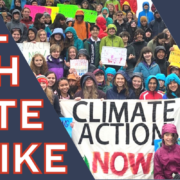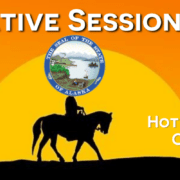Time to vote for reason.
[cs_content][cs_element_section _id=”1″ ][cs_element_layout_row _id=”2″ ][cs_element_layout_column _id=”3″ ][cs_element_text _id=”4″ ][cs_content_seo]Election season can make a person approach their mailbox with caution. It is hard to know what new flood of glossy mailers will fly out when you open the box as we get closer to election day. As you struggle with the question of what to do with all of these flyers – recycle them, tack them on the outhouse wall, use them for their marginal fire-starting capacity or keep them around for posterity on the coffee table – one thing is clear, the enormity of the questions before us this year is driving this daily mailbox assault.
You must vote. Voting is your role in deciding the future of Alaska. This year, in addition to voting for your local candidate who will bring your values and voice to Juneau, we will also vote for a Governor who will shape the politics of the next four years statewide for better or worse. We will also vote for a Congressional delegation representing Alaska’s voice in Washington D.C., and whether to hold a Constitutional Convention.
Whether to hold a convention is before us every decade and Alaskans have always said no by a large margin. Still, this year, due to arguments over the Permanent Fund Dividend, public funding for education, women’s reproductive freedom, the independence of the judiciary, and a limitless number of other political divisions in the state, backers of a convention are hoping there will be momentum for a yes vote this year. We cannot understate the danger of a Constitutional Convention at this moment.
Some candidates backing a convention want to turn Alaska into a place where women and LGBTQ2S+ people have fewer rights than men. They want to turn our state into a place where the judiciary is a pawn of the Governor and where corporations and wealthy individuals unduly influence the outcome of elections. It is time to hold these candidates accountable. We do this by voting.
Far-right incumbents in the State House and Senate have enabled Governor Dunleavy in his efforts to undermine Democracy and cut the state budget to the point where it can barely function. These are not responsible lawmakers.
At every turn, legislators like Oathkeeper David Eastman of Wasilla (who was at the January 6th rally-turned-insurrection) obstruct, grandstand, and delay lawmaking. Thankfully, a lawsuit has determined that Eastman is ineligible to serve because of his membership in the insurrectionist Oathkeepers organization, and lawmaker Lora Reinbold is retiring. But these leaders used the Covid-19 public health emergency in their time to create a political circus. Unfortunately, they are followed by candidates like Jamie Allard, who also excels at grandstanding, controversy, and spiteful anti-semitic acts. All of these candidates need to pack their bags.
Kenai Peninsula legislators Sarah Vance, Ben Carpenter, and Ron Gilham defy their own oath of office to protect the Constitution by seeking to have Alaska join the Texas lawsuit that sought to overturn the results of the 2020 election. Candidates who do not believe in free and democratic elections, promote harmful and dangerous conspiracy theories and work to undermine our Democracy have no place in Alaska politics.
There should also be no place for candidates who work against climate solutions or support Pebble Mine, maybe the most unpopular mining proposal ever in the state. Candidates who happily cash donations from the Pebble CEO for their campaigns (Mia Costello, Stanley Wright) or who have voted to support a Pebble appointee for the Board of Fish (Tom McKay, David Nelson, Laddie Shaw, among others) are not the leaders we need to see in a state that’s experiencing the climate crisis at 10x the national rate.
Extremist candidates and lawmakers put a strain on the body politic. By voting in reasonable, thoughtful candidates, we send a strong message that Alaska policymaking is essential, makes a difference in people’s lives, and is a space that welcomes a diversity of opinions. This November, it’s time to get back closer to being on track. Alaska politics have always been wild and full of surprises, so we should be under no illusion that being on track means a straight line from point A to point B. The road ahead will be challenging, but we can travel the road with greater dignity by voting out extremist candidates and holding accountable those who want to take away human rights.
Absentee ballots for the November 8 midterm elections are hitting mailboxes. Early voting will begin on October 24. You can find information on early voting sites near you at this website: https://www.elections.alaska.gov/avo/
The Alaska Center IE\n\n[/cs_content_seo][cs_element_gap _id=”5″ ][cs_element_button _id=”6″ ][cs_content_seo]Make a donation today to help us elect leaders who share our vision and values.\n\n[/cs_content_seo][cs_element_gap _id=”7″ ][cs_element_text _id=”8″ ][cs_content_seo]Paid for and approved by The Alaska Center IE, 808 E St, Suite 100, Anchorage, Alaska 99501. Susan Klein, Chair. The top contributors to The Alaska Center IE are Farhad Ebrahimi (Boston, MA), and Service Employee’s International Union 775 Quality Care Committee (Seattle, WA), and Stephen D Robbins (Anchorage, AK).
This NOTICE TO VOTERS is required by Alaska law. The Alaska Center IE certifies that this communication is not authorized, paid for, or approved by the candidate.
A majority of contributions to The Alaska Center IE came from outside the State of Alaska.
\n\n[/cs_content_seo][cs_element_gap _id=”9″ ][cs_element_button _id=”10″ ][cs_content_seo]More Hot Takes In A Cold Place\n\n[/cs_content_seo][/cs_element_layout_column][/cs_element_layout_row][/cs_element_section][/cs_content]









